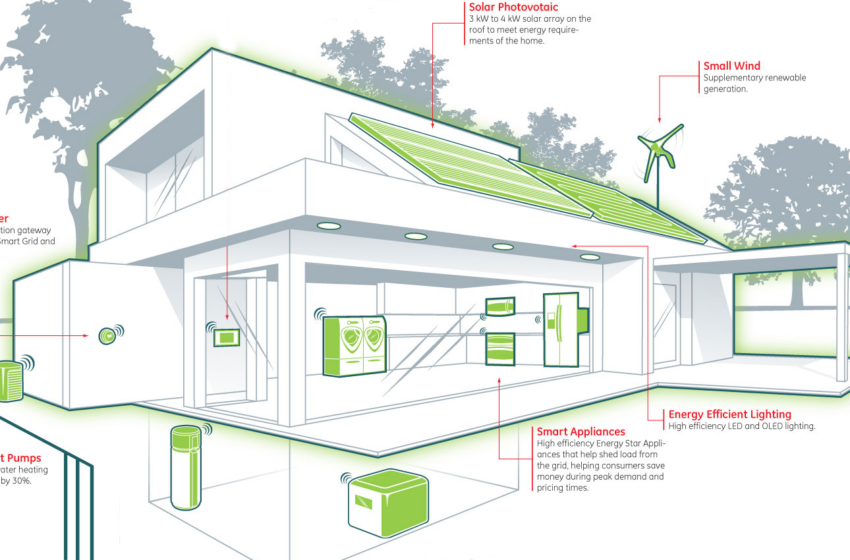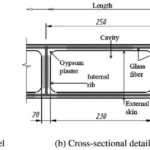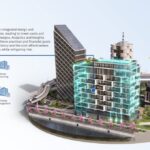
As the world continues to face the challenges of climate change and growing energy demands, the construction industry is exploring ways to minimize energy consumption and reduce carbon footprints. One of the most promising solutions in the realm of sustainable architecture is the concept of the Zero Energy Building (ZEB). These buildings produce as much energy as they consume over the course of a year, making them highly efficient and environmentally friendly.
In this blog, we’ll explore what a zero energy building is, how it works, and why it is crucial for the future of sustainable construction.
What is a Zero Energy Building (ZEB)?
A Zero Energy Building, often referred to as a Net Zero Energy Building (NZEB), is a structure that produces the same amount of energy as it uses annually. This balance is achieved through the integration of energy-efficient design and renewable energy systems. In essence, a ZEB operates with a net-zero energy consumption—the amount of energy consumed by the building over the year is equal to the amount of energy generated on-site from renewable sources, such as solar, wind, or geothermal.
The goal of a zero energy building is not only to reduce energy consumption but also to minimize greenhouse gas emissions, contributing to a more sustainable built environment.
How Do Zero Energy Buildings Work?
Zero Energy Buildings rely on a combination of energy-efficient design features and renewable energy systems. Here’s how they work:
- Energy-Efficient Design: The foundation of a Zero Energy Building is its energy-efficient design. This involves:
- Insulation and Airtightness: Proper insulation and airtight construction reduce the need for heating and cooling, which are typically the largest energy consumers in buildings.
- Energy-Efficient Windows and Doors: High-performance windows that minimize heat loss or gain help maintain a comfortable indoor temperature without overreliance on HVAC systems.
- Passive Solar Design: This includes optimizing the building’s orientation and layout to take advantage of natural sunlight for heating and lighting. By utilizing daylight, buildings reduce the need for artificial lighting.
- Efficient Lighting and Appliances: Energy-efficient LED lighting and energy-star rated appliances further reduce energy usage.
- Renewable Energy Systems: To offset the energy consumption, a Zero Energy Building is typically equipped with renewable energy systems. The most common systems include:
- Solar Panels: Photovoltaic (PV) panels installed on the roof or elsewhere on the property capture sunlight and convert it into electricity.
- Wind Turbines: In certain locations, small-scale wind turbines can be installed to generate electricity.
- Geothermal Heating and Cooling: Geothermal systems harness the earth’s natural heat to provide heating in the winter and cooling in the summer, reducing reliance on traditional HVAC systems.
- Energy Storage Systems: Batteries or other energy storage solutions help store excess energy generated during the day for use at night or during periods of low energy generation.
- Smart Technologies: Advanced building technologies play a critical role in optimizing energy use. These include:
- Energy Management Systems: These systems monitor energy usage and optimize heating, cooling, and lighting to ensure that energy is used efficiently.
- Smart Thermostats: Automated thermostats adjust the temperature based on occupancy and external conditions, reducing energy waste.
- Behavioral Changes: In addition to technology and design, achieving a Zero Energy Building also requires behavioral changes. Occupants can play a significant role by adjusting habits, such as reducing unnecessary lighting, using energy-efficient appliances, and minimizing heating or cooling requirements.
Why Are Zero Energy Buildings Important?
- Environmental Impact: One of the most important reasons for building ZEBs is the environmental benefit. Traditional buildings consume vast amounts of energy, contributing to carbon emissions and climate change. Zero Energy Buildings, by contrast, produce as much energy as they consume, significantly reducing their carbon footprint and helping to mitigate the impact of climate change.
- Reduced Energy Bills: Although the initial cost of building a Zero Energy Building can be higher due to the integration of renewable energy systems, the long-term savings can be substantial. With on-site energy generation, ZEB occupants can significantly reduce or eliminate their energy bills. In some cases, excess energy generated can be sold back to the grid, providing additional savings or income.
- Energy Independence: Zero Energy Buildings reduce dependence on external energy sources. By generating their own energy, these buildings can become less vulnerable to power outages, price fluctuations in energy markets, and disruptions in the energy supply.
- Health and Comfort: Zero Energy Buildings are designed with occupant comfort in mind. With energy-efficient insulation, ventilation systems, and access to natural light, these buildings often provide better indoor air quality and comfort than traditional buildings. Furthermore, by minimizing the use of fossil fuels, ZEBs can create healthier environments for their occupants.
- Increased Property Value: Properties with energy-efficient and sustainable features tend to have higher resale values. With the growing awareness of environmental issues and the increasing demand for energy-efficient homes, Zero Energy Buildings are becoming more desirable in the real estate market.
Challenges of Building Zero Energy Buildings
- High Initial Costs: The upfront costs of designing and constructing a Zero Energy Building can be higher due to the need for energy-efficient materials, renewable energy systems, and advanced technologies. However, these costs can be offset by long-term savings on energy bills and the building’s increased value over time.
- Geographical Limitations: The feasibility of a Zero Energy Building depends on its location. Solar and wind energy generation are more effective in areas with ample sunshine or wind. In regions with less favorable conditions, ZEBs may require larger or more expensive energy systems.
- Complex Design and Integration: Designing a Zero Energy Building requires a thorough understanding of building science, renewable energy systems, and energy-efficient technologies. Integrating these elements effectively can be complex and may require specialized expertise.
- Maintenance and Operation: Maintaining the renewable energy systems and energy-efficient technologies in a ZEB can require additional attention. Regular maintenance is necessary to ensure that the systems are operating at peak efficiency.
The Future of Zero Energy Buildings
As technology continues to evolve and the cost of renewable energy systems decreases, Zero Energy Buildings will become more accessible and widespread. Governments and organizations are increasingly promoting ZEBs through incentives and regulations, which will further drive the adoption of these buildings.
With the rise of smart cities and sustainable communities, Zero Energy Buildings are poised to play a critical role in shaping the future of urban development, ensuring that our buildings become more energy-efficient, self-sufficient, and environmentally friendly.

Zero Energy Buildings: The Key to a Sustainable Future in Construction
As the construction industry faces pressure to reduce its environmental impact, the demand for Zero Energy Buildings (ZEBs) continues to grow. These buildings, which produce as much energy as they consume, offer a solution to the ongoing global energy crisis by using renewable energy sources and optimizing energy consumption. In this blog, we’ll delve deeper into the growing trend of Zero Energy Buildings and the transformative impact they have on sustainable construction.
The Rise of Zero Energy Buildings
The concept of Zero Energy Buildings has been gaining momentum due to increasing concerns about climate change, energy use, and resource depletion. The construction industry has long been associated with high levels of energy consumption and carbon emissions, making it a critical focus area for sustainability efforts.
ZEBs are designed to address this issue by incorporating a variety of green building technologies and renewable energy solutions. This enables them to produce enough energy on-site to meet their annual energy consumption needs, leading to a net-zero energy balance. This is achieved through:
- Energy-Efficient Building Design: Maximizing insulation, air-tightness, natural lighting, and passive solar heating.
- Renewable Energy Systems: Solar panels, wind turbines, and geothermal systems that generate clean energy.
- Energy Storage: Batteries or other storage solutions to ensure energy is available when needed.
Benefits of Zero Energy Buildings
- Significant Energy Savings: The primary benefit of Zero Energy Buildings is that they drastically reduce the energy required from external sources, leading to major savings on utility bills. While it may require a larger initial investment, the long-term savings in energy costs often outweigh the upfront expenditures.
- Environmental Impact: ZEBs are a critical tool in the fight against climate change. By producing their own renewable energy, they help reduce greenhouse gas emissions, reduce dependence on fossil fuels, and contribute to a cleaner, greener planet.
- Resilience and Self-Sufficiency: Zero Energy Buildings are more resilient to power outages and energy price fluctuations because they generate their own power. With storage systems in place, they can maintain operations even during grid failures.
- Healthier Living Environments: ZEBs prioritize indoor air quality, lighting, and temperature control, creating healthier and more comfortable living spaces. With improved ventilation systems and the use of non-toxic building materials, ZEBs support the well-being of occupants.
Zero Energy Buildings in the Future of Construction
The future of construction lies in the integration of sustainable, energy-efficient designs that help combat global environmental challenges. Zero Energy Buildings represent a step in the right direction. As technology continues to advance, these buildings will become increasingly affordable and accessible, helping to reshape the built environment into one that is both energy-efficient and eco-friendly.
The adoption of ZEBs is not just a trend but a necessary shift toward a more sustainable future in construction. Governments, developers, and consumers alike are realizing the benefits of investing in Zero Energy Buildings, and we can expect this trend to grow as we work towards a carbon-neutral world.
In conclusion, Zero Energy Buildings are more than just energy-efficient—they are the cornerstone of sustainable development in construction. By investing in these innovative, eco-friendly buildings, we can create a greener, more sustainable future for generations to come.





